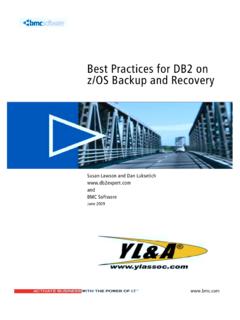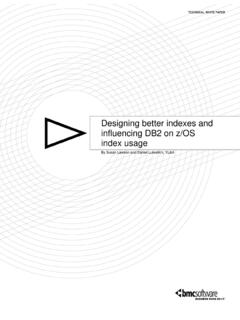Transcription of Designing better indexes and influencing DB2 on z/OS index ...
1 BMC, BMC Software, and the BMC Software logo are the exclusive properties of BMC Software, Inc., are registered with the Patent and Trademark Office, and may be registered or pending registration in other countries. All other BMC trademarks, service marks, and logos may be registered or pending registration in the or in other countries. All other trademarks or registered trademarks are the property of their respective owners. 2009 BMC Software, Inc. All rights reserved. Designing better indexes and influencing DB2 on z/OS index usage By Susan Lawson and Daniel Luksetich, YL&A Page | 2 THE TRUE COST OF IMS: IT S LESS THAN YOU THINK TABLE OF CONTENTS Introduction .. 3 index Utilization in DB2 on z/OS .. 3 Reasons to Use indexes .. 3 Types of indexes .. 3 Clustering .. 4 Partitioned.
2 4 Non-Partitioning Secondary index (NPSI) .. 4 Data Partitioned Secondary indexes (DPSI) .. 5 Unique index and Non-Unique index .. 5 index on Expression .. 5 How DB2 Matches 6 Stage 1 Indexable .. 6 Stage 1 Non-Indexable .. 7 Stage 2 .. 7 Application Layer Predicates .. 7 Boolean Term Predicates .. 7 influencing index Selection .. 8 Catalog Statistics .. 8 Proper Predicates and Promotion .. 8 influencing the Optimizer to Choose an index .. 10 Using Correlation or Non-Correlation to Maximize index Utilization .. 10 Tuning indexes with BMC Solutions .. 11 About the Authors .. 13 Page | 3 THE TRUE COST OF IMS: IT S LESS THAN YOU THINK INTRODUCTION indexes are one of the most powerful performance features of a relational database, and they are essential to support high performance applications.
3 Proper index design and utilization is critical when Designing a database with the goal of balancing costs with performance. indexes use disk space, and they increase the cost of insert, delete, and some update operations, but they also enforce business rules, keep data organized, and speed access to the data. A proper understanding of how DB2 uses indexes is critical to the proper management of your databases and database applications. You need to know how DB2 will match predicates to index columns, and what techniques you can use to maximize index matching while minimizing the number of indexes (at least for databases that are updated). You also need to be aware of how queries are using indexes , and if you can improve the index utilization for those queries. Doing so could be the most significant performance enhancement you can provide for you DB2 applications.
4 For high performance DB2 applications it is important not only to understand how DB2 is optimizing its access to the data, but also how much data is being processed and retrieved at each stage of the SQL statement. Filtering as much as possible - as soon as possible - is essential to achieving optimal application performance. This paper discusses index design and query performance topics, including best use of index matching predicates, index screening, and influencing DB2 to use particular indexes . index UTILIZATION IN DB2 FOR Z/OS A DB2 index is a list of the locations of rows sorted by the contents of one or more specified columns. We typically use indexes to improve query performance. However, indexes can also serve a logical data design purpose. For example, a unique index does not allow the entry of duplicate values in columns, thereby guaranteeing that no rows of a table are the same.
5 You can create indexes to specify ascending, descending, or random order by the values in a column. The indexes contain a pointer, known as a record ID (RID), to the physical location of the rows in the table. REASONS TO USE indexes There are three main reasons to create indexes : To improve query performance To ensure uniqueness of values To ensure a physical clustering sequence of table data You can create more than one index on a particular base table. However, the more indexes you have, the more the database system must work to keep the indexes current during update, delete, and insert operations. Creating a large number of indexes for a table that receives many changes can slow processing, and a large number of indexes can lead to longer outages during maintenance work like reorganizations or loading for data.
6 indexes consume disk space. The amount of disk space varies depending on the length of the key columns, compression option, and whether the index is unique or non-unique. index size and levels increases as you add more data into the base table. Therefore, consider the disk space required for indexes when planning the size of the database. Some of the key index design rules are: Primary and unique key constraints require a unique index . PCTFREE and FREEPAGE can greatly help insert performance. Create a clustering index if you need to read ranges of data to utilize sequential prefetch. Create indexes on foreign key constraint columns to speed certain operations Page | 4 THE TRUE COST OF IMS: IT S LESS THAN YOU THINK TYPES OF indexes Let s look at some types of indexes in DB2 and discuss some best practices.
7 This paper does not cover all index types, such as XML and LOB indexes , but it discusses index techniques that can enhance performance for your SQL statements. Clustering In general, it s not that important to control the physical sequence of the data in a table. But to utilize sequential reads for range processing through an index , use the CLUSTER option on one, and only one, index on a table to specify the physical sequence. Without this option, the first index defined on the table in a non-partitioned tablespace is used for the clustering sequence. Be careful when you have multiple indexes on a table, and don t rely on that first index for clustering, because if you need to drop and recreate this first index , another index will become the first index and the clustering in the table will be changed during the reorg, load or recover of the tablespace.
8 The best clustering index is one that supports the majority of the sequential access to the data in the table. For example, if a large batch process reads data based on an input key in a specific order, it may be best to make the column corresponding to that input sequence the clustering key. Tables that are often accessed together in the same process can benefit from being clustered on a common value, which can promote the use of sequential detection and index lookaside, as well as minimize random I/O operations. Partitioned To create an index that is partitioned according to the partitioning scheme of the underlying data, specify the PARTIONED keyword on the CREATE index statement. Two types of partitioned indexes are available: partitioning and secondary. For an index to be considered a partitioning index , the specified index key columns must match or comprise a superset of the columns specified in the partitioning (limit) key, must be in the same order, and must have the same ascending or descending attributes.
9 If an index on a partitioned tablespace does not have the attributes of a primary partitioning index , it is considered a secondary index . When table-controlled partitioning is in place, the index definition simply needs to include the PARTITIONED keyword to indicate that the index is a partitioned index . Just like the partitioned tablespace, the partitioned index consists of several data sets. Each partition can have different attributes (some may have more free space than others). Non-Partitioning Secondary index (NPSI) NPSIs are indexes that are used on partitioned tables. They are not the same as the partitioning key, which is used to order and partition the data; rather, they improve access to the data. While partitioning and partitioned indexes have one index partition per tablespace partition, one NPSI will reference the entire tablespace, spanning all partitions.
10 NPSIs can be unique or non-unique. You can break NPSIs into multiple pieces (data sets) by using the PIECESIZE clause on the CREATE index statement. Pieces can be 254 K to 64 GB; the best size will depend on how much data you have and how many pieces you want to manage. If you have several pieces, you can achieve more parallelism on processes such as heavy INSERT batch jobs by alleviating the bottlenecks caused by contention on a single data set. The following example shows how to create an NPSI with 1M pieces. CREATE UNIQUE index ON (LASTNAME ASC) PADDED USING STOGROUP DSN8G910 PRIQTY 512 SECQTY 64 ERASE NO BUFFERPOOL BP1 CLOSE YES PIECESIZE 1M; Page | 5 THE TRUE COST OF IMS: IT S LESS THAN YOU THINK Data Partitioned Secondary indexes (DPSI) The data partitioned secondary index (DPSI) provides many advantages for secondary indexes on a partitioned tablespace over the traditional NPSIs in terms of availability.


